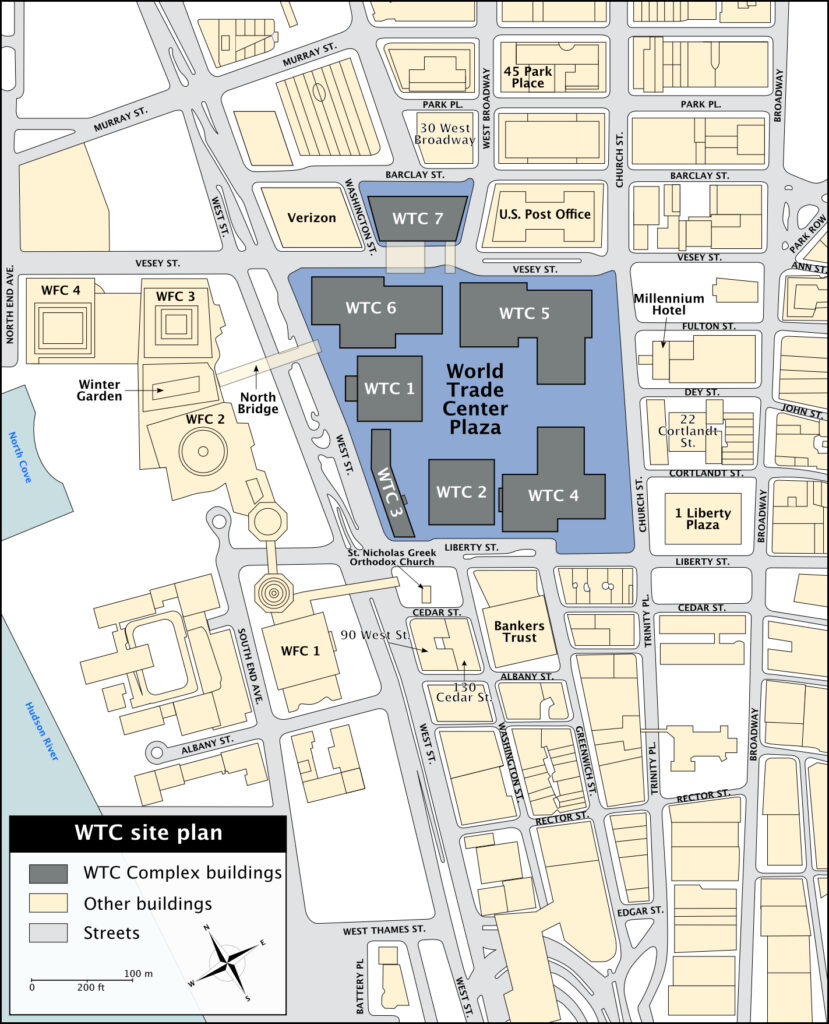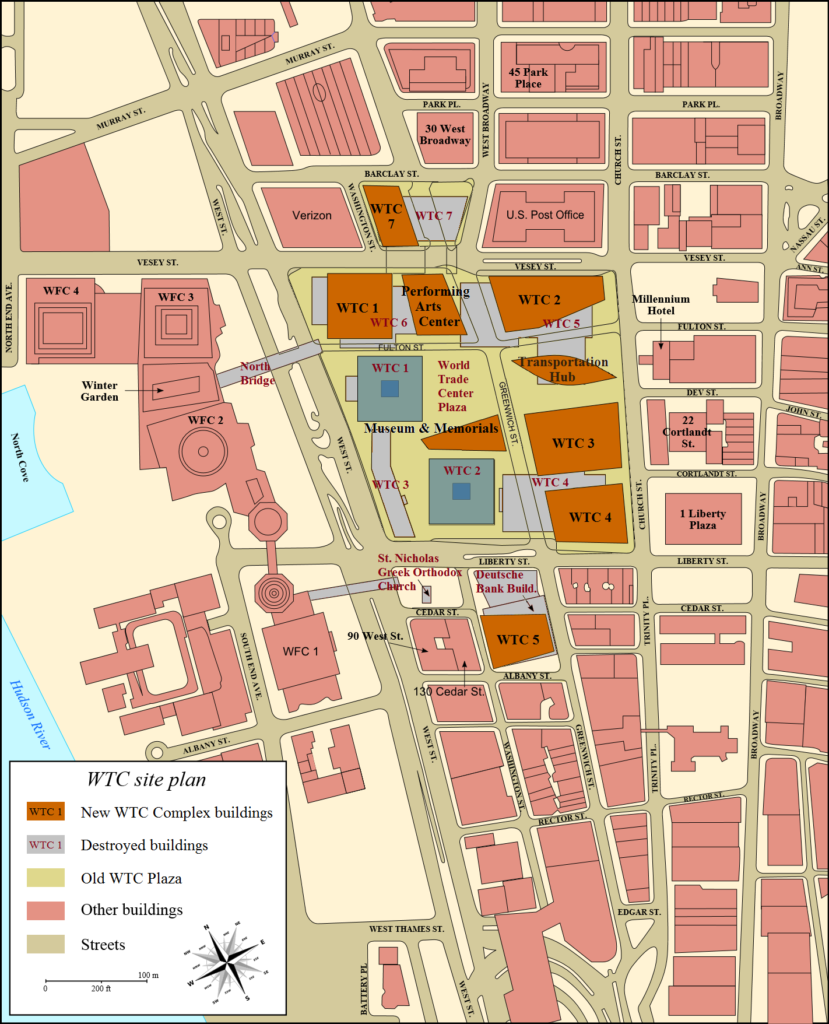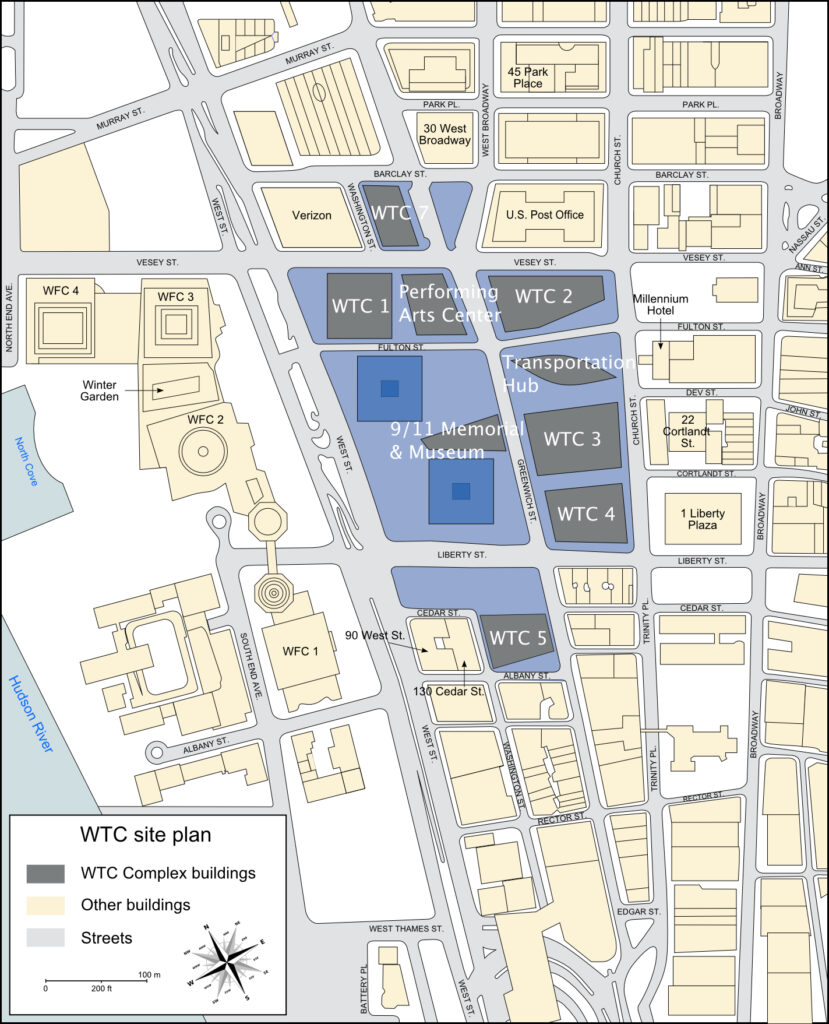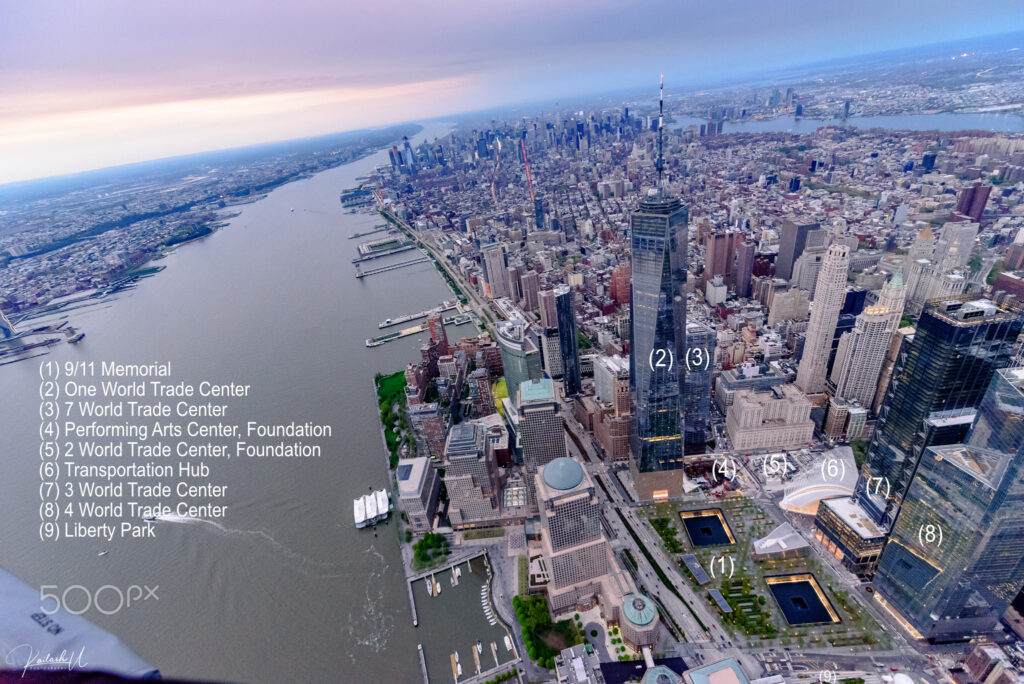Reading Black Market by James Patterson, copyrighted in 1986, about a terrorist attack on the financial district of New York City brought 9/11 back vividly. The devastation described from the story’s bombings – the dense hydrocarbon clouds of smoke, flames raging out of control, billions of tons of granite block, shattered glass, and concrete and mortar that had crashed down – still doesn’t even touch the horror of that day. That truth is often more devastating than fiction.
It’s one of those days – people remember exactly where they were and what they were doing when the World Trade Center Twin Towers were hit on September 11th, 2001.
Although the material destruction of the day pales against the human cost, this book, remembering, and the anniversary of that day got me curiously googling about the reconstruction. This blog entry touches on the destruction but focuses on the rebuilding process.
This is a map of the World Trade Center building locations before 9/11.

Image 1: https://commons.wikimedia.org/wiki/File:WTC_Building_Arrangement_and_Site_Plan.svg
MesserWoland, CC BY-SA 3.0 <http://creativecommons.org/licenses/by-sa/3.0/>, via Wikimedia Commons
All the World Trade Center buildings (colored dark grey,) were destroyed on that black day. The Twin Towers (WTC 1 and 2,) from the terrorist hit, and WTC 3 through 7 from the collapse of the towers. WTC 7 collapsed later in the day and destroyed Fiterman Hall at 30 West Broadway. WTC 3, 4, 5 and 6 were damaged beyond repair as well as the historic St Nicholas Greek Orthodox Church, and Bankers Trust (later known as Deutsche Bank).
Inception & Destruction.
Openings
The original World Trade Center officially opened on April 4, 1973. It was a 16-acre complex, designated zip code 10048, that was or would be home to the World Trade Center buildings, and the five-acre Plaza. Buildings open at this time were 1 WTC, 2 WTC, 5 WTC, and the World Trade Center Plaza.
WTC Buildings Opening Years:
1970 – 1 World Trade Center
1972 – 5 World Trade Center
1973 – 2 World Trade Center
1974 – 6 World Trade Center
1977 – 4 World Trade Center
1981 – 3 World Trade Center
1987 – 7 World Trade Center
Summary of Destruction on 9/11
Note: The World Trade Center complex and the surrounding rubble came to be known as Ground Zero in Lower Manhattan.
1 WTC also known as the North Tower was the first to be struck by a hijacked plane at 8:46 am. It was the second tower to collapse, at 10:28 am.
2 WTC also known as the South Tower was the second to be struck by a hijacked plane at 9:03 am. It was the first tower to collapse, at 9:59 am.
3 WTC was severely damaged by the South Tower fall. Its remains were demolished as part of the Ground Zero cleanup.
4 WTC was crushed by the collapse of the South Tower fall. Its remains were demolished as part of the Ground Zero cleanup.
5 WTC was gutted by fire and debris after the successive collapses of the nearby Twin Towers. It was demolished as part of the Ground Zero cleanup.
6 WTC. The North Tower’s collapse left deep craters in 6 WTC. It was demolished as part of the Ground Zero cleanup.
7 WTC. As the North Tower collapsed, debris hit 7 WTC’s southern facade, triggering a major fire that burned uncontrolled for almost seven hours until 7 WTC collapsed at 5:20 pm.
WTC Plaza. The collapse of the Twin Towers destroyed the plaza, but The Sphere, a bronze sculpture by German artist Fritz Koenig in the center of the plaza suffered only slight damage. It was moved temporarily to nearby Battery Park in 2002 and put on display as a tribute to the victims of the attacks.
Deutsche Bank Building at 130 Liberty Street (shown as Banker’s Trust in Image 1.) Debris from the collapse of the South Tower left a huge gash in its northern façade, and it was contaminated with toxic dust and mold caused by rain that blew in through its broken windows. It was eventually declared uninhabitable and a total loss and demolished in 2011.
Fiterman Hall at 30 West Broadway. At 5:20 p.m., the collapse of 7 WTC across the street from Fiterman Hall caused a huge pile of debris to pile up against the college’s southern facade and penetrate the exterior. Toxic dust and mold infested the building, making it uninhabitable. After decontamination, the deconstruction started in 2009.
Saint Nicholas Greek Orthodox Church at 155 Cedar Street was flattened by the collapse of the South Tower.
The Cortlandt Street Station. The Cortlandt Street station was destroyed. The station’s reconstruction was delayed until 2015 because the Port Authority had to first rebuild the World Trade Center PATH station beneath it.
Other buildings damaged
The World Financial Center buildings, 90 West Street, and 130 Cedar Street suffered fires. The Verizon Building and 3 World Financial Center had impact damage from the towers’ collapse.
The map below shows the original building locations overlaid with the planned reconstruction colored burnt orange.
Rebuilding from Ground Zero
Many factors came into play with the reconstruction of the World Trade Center. First among them was the need and desire to create some kind of memorial to honor those who died at the hands of terrorists, and secondly an adamant rejection of rebuilding the Twin Towers over their original footprints. That seemed morally wrong and emotionally devastating.
The Case of Greenwich Street.
A third factor arose during the design phase. New Yorkers wanted Greenwich Street back.
The streets of Manhattan were built on a grid. The Superblock that was the Original World Trade Center Complex disrupted that design, with no streets running through the 16-acre complex. The north/south Greenwich Street dead-ended at the complex from both the north and south direction.
The new World Trade Center design restored both Greenwich Street and the east/west Fulton Street through the complex.
Once the design was accomplished, multiple stakeholders, the economy, land rights, funding, and obtaining permits and approvals played a part in determining the scheduling for the rebuilding process, often causing major delays.

Image 2: File:WTC Building Arrangement and Site Plan Overlay.png
https://commons.wikimedia.org/wiki/File:WTC_Building_Arrangement_and_Site_Plan_Overlay.png
Bundesstefan, CC BY-SA 3.0 <https://creativecommons.org/licenses/by-sa/3.0>, via Wikimedia Commons
Construction Timeline
Temporary PATH Rail Station Opened November 23, 2003
A temporary rail station for the Port Authority Trans-Hudson (PATH) network connecting New York City’s Manhattan borough with northeastern New Jersey was built on the eastern side of the 6 WTC footprint where the Performing Arts Center will later be located. Its opening on November 23, 2003 restored the Lower Manhattan service that had been suspended since 9/11.
Recreations & New Additions by Open Date.
1) New Addition: Silverstein Family Park opened in 2004.
The triangular portion of the original footprint of 7 WTC that remained on the eastern side of the rebuilt Greenwich Street was made into a park area.
2) 7 World Trade Center Opened May 23, 2006 (aka 250 Greenwich Street)
Construction of the new 52-floor glass tower began in November 2002. It was the first of the WTC buildings to be rebuilt and was built over part of its original footprint on the west side of the restored Greenwich Street.
3) The World Trade Center Memorial Opened September 11, 2011
Construction of the memorial project started on March 13, 2006, on the land previously occupied by WTC 1, 2, and 3. The 8-acre memorial was dedicated in a ceremony for victims’ families on September 11, 2011, and opened to the public the next day featuring two square reflecting pools marking where the twin towers stood.
Combined, the bronze parapet surrounding the North and South pool displays the names of all 9/11 victims and those killed in a February 26, 1993, terrorist bombing beneath the North Tower.
Two small buildings also are located on the footprint of the former hotel WTC 3. They contain service spaces, and a security command post, and provide ventilation for facilities underneath the plaza.
4) Fiterman Hall Opened August 27, 2012 (at 30 West Broadway)
Fiterman Hall is part of CUNY the Community College of New York. After many delays in the deconstruction of the old building, construction on the new 14-story building began on December 1, 2009, on its original site.
5) 4 World Trade Center Opened on November 13, 2013 (aka 150 Greenwich Street)
Construction began in January 2008. The new 72-floor building was built on part of its original footprint. With a height of 297 meters, it is the 4th tallest skyscraper in the WTC complex.
6) New Addition: Underground Vehicle Security Center Opened October 31, 2014
The Vehicle Security Center serves as a screening facility for trucks and buses entering the World Trade Center’s underground concourse.
Excavation for the Vehicle Security Center began in mid-2010, and the Liberty Street entrance structure in 2011. It was completed three days before One World Trade Center officially opened.
The entrance with its one-story concrete roof is constructed on the northern portion of the Bankers Trust footprint and part of the site previously occupied by the Saint Nicholas Church.
7) One World Trade Center Opened November 3, 2014
The cornerstone was laid on July 4, 2004. Construction progressed slowly but was fully underway by 2011. The new 104-story building, initially named “Freedom Tower,” reaches a height of 542 meters or 1,776 feet, a figure meant to honor U.S. Independence. The name was changed in 2009 to One World Trade Center. It is the tallest building in the Western Hemisphere as well as in the complex.
8) The 9/11 Museum opened May 14, 2015, on Memorial Plaza grounds.
Construction began along with the memorial on March 13, 2006, on the 8-acre memorial grounds previously occupied by WTC 1, 2, and 3. An above-ground entry pavilion leads to the below-ground museum spaces designed to tell the story of 9/11.
9) World Trade Center Oculus and PATH station Opened on March 3, 2016.
Design modification delayed the start of construction to July 2008. It was built on the southern part of the original WTC 5 and serves as a station for the Port Authority Trans-Hudson (PATH) rail. With its opening, the nearby temporary station closes.
The station’s distinctive white roof features two wing-like upward-sloping ribs sitting atop two arches. It is intended to resemble a dove released from the hands of a child. Between the arches is a narrow skylight that opens up on temperate days and annually on 9/11.
10) New Addition: Liberty Park Opens June 29, 2016. (155 Cedar Street.)
Construction on the park began in 2014. The rectangular-shaped park sits on the roof of the Vehicle Security Center Liberty Street Entrance. The bronze sculpture The Sphere by German artist Fritz Koenig which stood in the original World Trade Center plaza was relocated to Liberty Park in 2017.
11) 3 World Trade Center opened June 11, 2018.
Construction began March 8, 2010, on part of the footprint of the original 4 WTC. The new 80-floor building, with a height of 328 meters, is the 3rd tallest tower in the WTC complex.
12) Cortlandt Street Subway Station Reopened at the WTC on September 8, 2018.
Reconstruction of the Cortlandt Station, located under the intersection of Greenwich Street and Cortlandt Way within the World Trade Center, was delayed until 2015 because the Port Authority had to first rebuild the World Trade Center PATH station beneath it.
After an extensive reconstruction, the Cortlandt Street station reopened on September 8, 2018, as WTC Cortlandt.
13) New Addition. 9/11 Memorial opened The Glade on May 30, 2019 (Memorial)
Construction on the Memorial grounds for The Glade began in May 2018. It is a dedicated space to honor first responders, recovery workers, and those who have died or are suffering from health-related issues as a result of the attack.
14) Saint Nicholas Greek Orthodox Church opened in August 2021.
Construction of the new church began on October 18, 2014. It is located in Liberty Park on the eastern side overlooking the National September 11 Memorial & Museum.
15) Ronald O. Perelman Performing Arts Center opened September 13, 2023
Construction began in 2018, following the closure and then demolition of the temporary PATH station. The 42-meter-tall cube-shaped venue is built on the eastern end of the WTC 6 footprint and covers a small corner of the southwestern edge of the original WTC 5 footprint. It is on the western side of the reconstructed Greenwich Street replacing the temporary PATH Rail Station that was torn down after the opening of the new PATH Station in 2016.
16) 2 World Trade Center – Not Complete (aka 200 Greenwich Street)
Construction of 2 World Trade Center technically began in 2008 and progressed in a start/stop fashion. Still, everything up to street level was completed in 2012, but then construction was halted by developer Silverstein Properties until it could find anchor tenants to help with obtaining needed funding for the tower. It is being built on the northeastern part of the complex on the east side of the newly established Greenwich Street.
The new 82-story building is designed to have a height of 410 meters (1,345 feet,) which would make it the 2nd tallest building in the complex and the 5th tallest in New York City.
There is no estimated date of completion.
17) 5 WTC – Not Complete but approved. (aka 130 Liberty Street)
The proposed 80-floor 5 World Trade Center building plans were approved in 2023, and construction is to start this year, 2024. 5 WTC is to be built on land that was the southern part of the Deutsche Bank Building (aka Bankers Trust) footprint. If designed as planned it will be the 5th tallest building in the WTC complex.
There is no estimated date of completion.
Buildings that were not reconstructed.
1) Marriott Hotel – the former 3 WTC
The Marriot Hotel was not redeveloped but 3 WTC was built as a newly purposed structure.
The site of the former Marriott hotel became part of the 9/11 Memorial Plaza,
2) 6 World Trade Center.
The building served as the U.S. Customs House for New York. Its site footprint is now the location of the new One World Trade Center and the Perelman Performing Arts Center.
3) Deutsche Bank Building (aka Bankers Trust) at 130 Liberty Street.
The northern part of the footprint of the building was used partly for the construction of the Vehicle Security Center entrance to service the World Trade Center complex. The southern part is the site reserved for 5 World Trade Center.
Below is the Site map of the new World Trade Center Construction Sites

Image 3: File:WTC Building Arrangement in preliminary site plan.svg
https://commons.wikimedia.org/wiki/File:WTC_Building_Arrangement_in_preliminary_site_plan.svg
Following: The World Trade Center Complex as of May 5th, 2018

Image 4: https://commons.wikimedia.org/wiki/File:The_Memorial_(256853923).jpeg
Kailash U, CC0, via Wikimedia Commons. (The text notations were added by JoAnn Wilburn)
References:
Ground Zero – Then and Now
By Michael Lipin written September 11, 2021
https://projects.voanews.com/ground-zero/
New World Encyclopedia
https://www.newworldencyclopedia.org/entry/World_Trade_Center
Britannica.com
Wikipedia.com
Article World Trade Center (1973 – 2001)
